Large-scale amphibian conservation often relies on remotely sensed data to describe spatial patterns in occupancy. Commonly used data include ownership, forest type, soil class, and proximity of wetlands. We evaluated the influence of these variables on terrestrial amphibian occupancy in southern Michigan. We trapped amphibians using drift-fence arrays in 82 forest patches and estimated detection probabilities for all captured species. Ten species were captured, but only three were detected at levels suitable for occupancy modeling. We concluded that drift-fence arrays alone were not sufficient for adequately detecting the majority of terrestrial amphibians. The best detection models for American Toad (Anaxyrus americanus), Wood Frog (Lithobates sylvaticus), and Spring Peeper (Pseudacris crucifer) consistently included a positive relationship with temperature and precipitation. Detection-adjusted occupancy models for the three anurans indicated relatively high occupancy (>0.43). Ownership, forest type, and soil class did not occur in higher ranking occupancy models. Rather, the higher ranking models often included the distance to National Wetlands Inventory (NWI) wetland and sample year factors. However, these effects were highly variable and of no use in consistently predicting terrestrial amphibian occupancy. Our results substantiate the importance of incorporating detection probabilities into studies of amphibian habitat relationships and suggest that coarse descriptors of environmental conditions may not adequately portray factors important to terrestrial amphibian occupancy.
How to translate text using browser tools
1 March 2011
Factors Associated with Amphibian Detection and Occupancy in Southern Michigan Forests
Gary J. Roloff,
Tracy E. Grazia,
Kelly F. Millenbah,
Andrew J. Kroll
ACCESS THE FULL ARTICLE

Journal of Herpetology
Vol. 45 • No. 1
March 2011
Vol. 45 • No. 1
March 2011




